What is climate change vulnerability?
Climate change vulnerability refers to the susceptibility of communities to climate-related impacts. Historically marginalised groups, facing limited resources and systemic inequalities, often bear a disproportionate burden. Inequity arises from unequal exposure and adaptive capacity, exacerbating vulnerability. Addressing this requires inclusive policies, considering specific needs, and promoting fair resource distribution for enhanced resilience.
“Climate change will lead to changes in geophysical, biological and socio-economic systems. An impact describes a specific change in a system caused
by its exposure to climate change. Impacts may be judged to be harmful or beneficial.
Vulnerability to climate change
is the degree to which these systems are susceptible to and unable to cope with adverse impacts.
The concept of risk, which combines the magnitude of the
impact with the probability of its occurrence, captures uncertainty in the
underlying processes of climate change, exposure, impacts and adaptation.”
(Source: IPCC – Assessing key vulnerabilities and the risk from climate change).
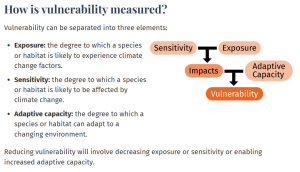
(Source: Climate Adaptation Explorer)
Read more:
Explaining differential vulnerability to climate change: A social science review
2. What is disaster or climate change mitigation?
“In the climate context, mitigation usually refers to actions
that communities take to reduce greenhouse gas emissions (GHG)
and limit long-term damage from continued climate change.”
(MRSC Empowering Local Governments).
Mitigation can be used under its generic term to lessen impacts of disasters that are fueled by climate change.
3. What is climate change adaptation?
Climate change adaptation focuses on actions taken to increase our ability to withstand the consequences of climate change. This includes effects of hotter, drier summers, more intense storms and flooding, rising sea levels and other effects that may create impacts for organisations and the communities we serve, such as the liveability of certain areas, fire risk, food security and more.
Read more
What is Climate Adaptation, Mitigation & Resilience?
4. What is the difference between climate change adaptation and disaster resilience?
The difference between climate change adaptation and disaster resilience is often discussed in the sector, and definitions can vary even among experts. Despite this, both concepts overlap when done well. Climate change adaptation involves making changes in response to the impacts of climate change that are already happening or are expected to happen. This can include a wide range of actions, such as altering farming practices to cope with new weather patterns or modifying infrastructure to handle rising sea levels.
“Ideally, responding to climate impacts that are already occurring
should be labelled as adaptation while preparing for those that will likely occur in the future
is referred to as building resilience.
Note, however, that the terms are often used interchangeably or simultaneously”
(MRSC Empowering Local Governments).
Disaster resilience, on the other hand, focuses specifically on preparing for and responding to disaster events like hurricanes, floods, or wildfires. It’s about making sure communities, buildings, and systems can survive and recover from these events. While Disaster Resilience is generally associated with immediate, short-term events, climate change adaptation deals with a broader set of challenges. Adaptation includes long-term changes to address a variety of climate impacts, not just those that result in disasters.
In practice, climate change adaptation often enhances disaster resilience. For example, building sea walls to adapt to rising sea levels can also protect against storm surges, improving resilience. Similarly, efforts to strengthen buildings or develop early warning systems for disasters can be seen as part of adaptation if they address risks linked to climate change.
5. What is adaptive capacity?
Adaptive capacities include the social and technical skills of individuals and groups to address environmental and socioeconomic changes. Specifically in food systems, these capacities are utilised to sustain livelihoods, food production, and access. It is essential to distinguish adaptive capacity from mitigation in the context of climate change. While adaptive capacity is deployed to respond to perturbations and shocks induced by climate change, mitigation involves proactively reducing the overall threat of climate change through measures such as emissions reduction, dietary changes, or atmospheric geoengineering (Source: We Adapt).
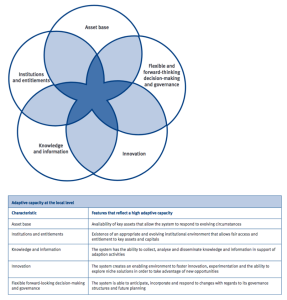
(Source: We Adapt)
6. What is disaster preparedness?
Disaster preparedness involves actions taken in advance by governments, organisations, communities, or individuals to better handle the immediate impacts of a disaster. The goal is to lessen the loss of life and livelihoods. This involves identifying vulnerabilities, implementing policies, and executing projects that minimise the likelihood of disasters occurring or diminishing their severity. The goal of disaster preparedness is to limit the damage to lives, property, and the environment by addressing underlying risk factors and enhancing community resilience against various hazards, ultimately leading to a safer and more sustainable future.
Due to factors such as population growth, rapid urbanisation, climate change, environmental degradation, and widespread poverty, more people and assets are at risk of disasters. Fragile and conflict-affected states face added challenges. However, better practice and response can save lives, enhance resilience, and reduce the impact of disasters.
(Source: Civil Protection Humanitarian Aid)
7. What is climate change resilience?
Disaster resilience refers to our ability to recover from an extreme event, and preparedness enhances our ability to bounce back quickly. Climate change increases the likelihood and intensity of disasters, so disaster resilience should incorporate climate change resilience. The community sector plays a valuable role in contributing to climate change adaptation and risk resilience. Community organisations should respond in their strategic planning and operational decisions, such as designing or retrofitting infrastructure or designing new services to meet identified needs.
Read more:
Power in resilience and resilience power in climate change scholarship
8. What is maladaptation to climate change?
Maladaptation to climate change occurs when efforts intended to address its impacts inadvertently worsen the situation. This may involve short-term solutions that sacrifice long-term sustainability or inadequate consideration of social and economic factors. To avoid maladaptation, it is essential to assess the consequences of actions and include the insights of people with lived experience and diverse vulnerabilities in climate-change risk areas.
Read more: Maladaptation: An Introduction
9. What are resilience capacities and transformative capacities?
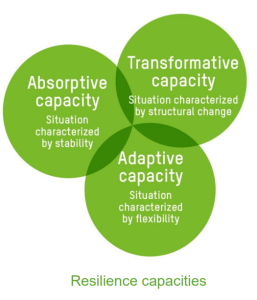
(Oxfam: Absorb, Adapt, Transform: Resilience Capacity, Oxfam)
The concept of transformation involves making fundamental changes in the deep structures that contribute to vulnerability and risk, both within societies and globally. It goes beyond addressing immediate causes and focuses on the underlying failures of development and power imbalances that perpetuate risk and poverty. Oxfam defines transformation as a profound shift in the structures that cause and sustain poverty and injustice. Transformative capacity, in this context, refers to the ability of individuals to initiate and engage in lasting changes that address the root causes of poverty, injustice, vulnerability, and risk. This involves a strong sense of agency, understanding, and active participation in long-term processes that challenge power dynamics, beliefs, values, and behaviours to promote justice and equity. Collaboration, mutual reinvention, informed decision-making, quick learning and adaptation, flexibility, and momentum are integral to transformative capacity. The transformation of organisations and systems is closely tied to individual transformation, encompassing shifts in attitudes, consciousness, motivation, and beliefs. However, it is emphasised that change at the local level, such as within households, may not fundamentally alter all the structures of poverty at broader societal levels. For instance, addressing gender justice within households alone may not change the larger structures of gender inequality in society. (Source: Absorb, Adapt, Transform: Resilience Capacity, Oxfam)
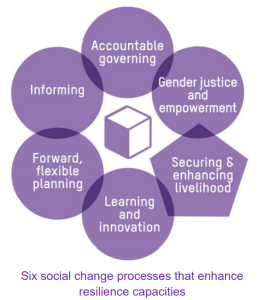
(Source: Absorb, Adapt, Transform: Resilience Capacity, Oxfam)
10. What is community and organisational disaster recovery?
Disaster recovery refers to the process of rebuilding and restoring a community or organisation in the aftermath of a significant and often disruptive event, such as a natural disaster, technological failure, or any other catastrophic incident. The primary goal of disaster recovery is to bring affected systems, infrastructure, and services back to normal functioning, minimising the impact on people’s lives and the overall community or organisational well-being. This comprehensive approach involves assessing the damage, developing strategic plans, allocating resources, and implementing measures to recover, rehabilitate, and reconstruct the affected areas. Successful disaster recovery not only addresses immediate needs but also considers long-term resilience and preparedness for future potential disasters. The three phases of recovery include short-term, intermediate and long-term recovery (Source: Planning for post-disaster recovery: Next generation).
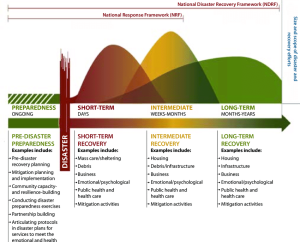
(Source: Planning for post-disaster recovery: Next generation)
11. What are the international commitments of disaster preparedness and resilience?
Disaster preparedness and resilience concepts are agreed upon and embedded into several international commitments, including:
The Sendai Framework for Disaster Risk Reduction (2015)
The Paris Agreement (2015)
The Agenda 2030
The New Urban Agenda
The Grand Bargain
